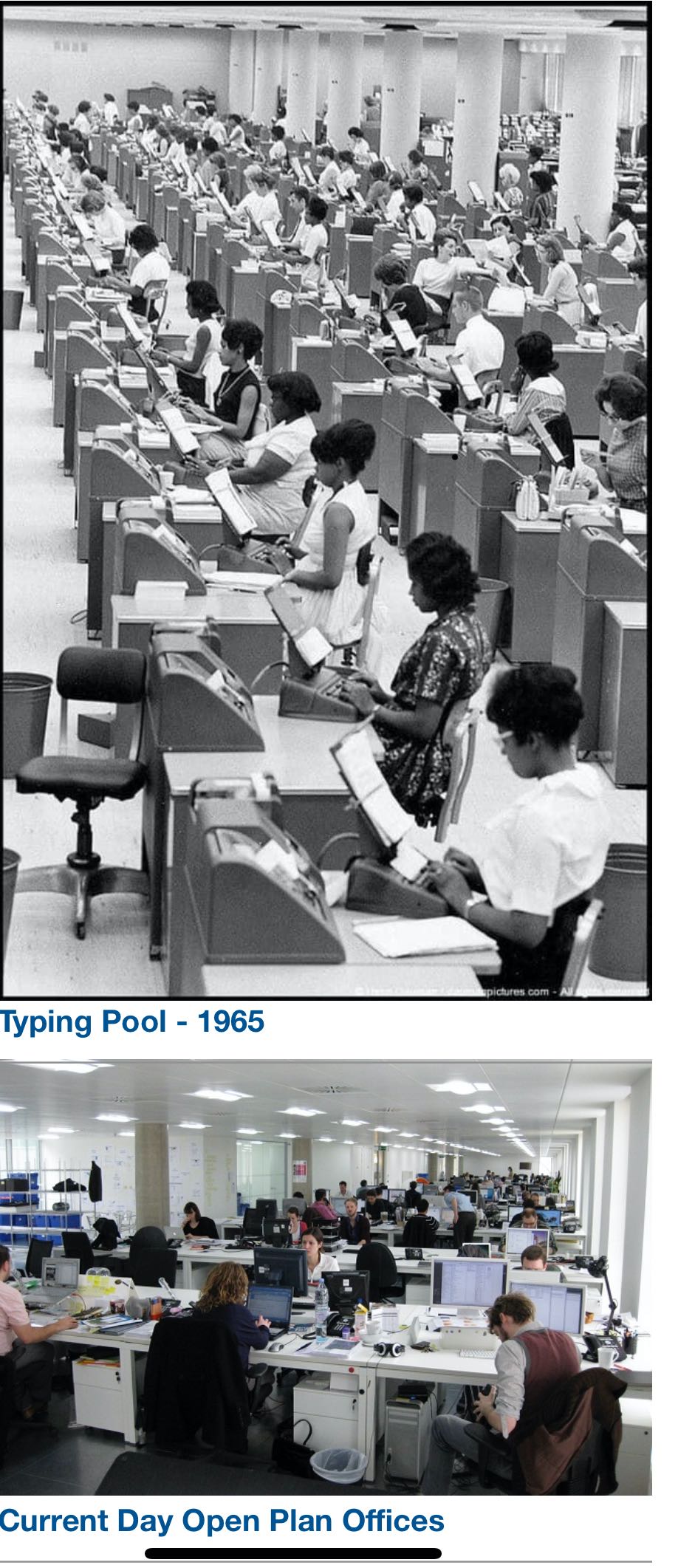Thoughts About the Future of the Workplace, Issue 6

The most commonly accepted rule in London is that 100 sf per employee is the ideal amount of space per person. This allows for roughly 50 sf for desk space and another 50 sf to accommodate room in communal areas, like breakout spaces, meeting rooms and kitchen. High rents in Central London mean many companies opt for the more cost-efficient ratio of 70-80 sf per person. (https://hubblehq.com/blog/how-much-office-space-do-i-need )

London is perhaps the most expensive office market in the world, and thus the impetus for the very low space per person office ratio. However, office spaces have been getting smaller and smaller everywhere. In North America the average amount of floor space per employee dropped from 250 sf in 2010 to 151 sf per worker in 2017. (https://mehiganco.com/?p=684 ) The wide-open work spaces and low sf per person ratios are just a part of the story. There are tiny meeting rooms, heavily populated communal areas, over-crowded elevators, and busy public transit.
Are these work environments that will encourage an enthusiastic return to work given that the general public has adopted and accepted social-distancing practices as an effective means to reduce the spread of Covid-19 specifically and other infectious diseases more generally? How much space per person and other measures will be required to make employees feel confident that the level of disease transmission risk is acceptable? What strategies will employers deploy to reduce population density in the workplace? What protocols shall be put in place to monitor and protect the health of the on-site workforce?
Also, there has been a significant movement to consolidate work forces in single locations:
- TORONTO, April 12, 2017 /CNW/ – CIBC (TSX:CM) (NYSE:CM) announced today that it has agreed to become the anchor tenant of Bay Park Centre, a new urban campus at 81 and 141 Bay Street, Toronto, that will be developed and jointly managed by Ivanhoé Cambridge and Hines, with construction starting this spring. The world-class complex will serve as CIBC’s headquarters and a campus for approximately 15,000 of the bank’s Toronto-area employees. At the time of this announcement CIBC was expected to be renting 1.75 million sf for 15,000 employees or 116.7 sf per employee.
- Kevin Peesker: Today I announced that our HQ will move to Toronto in 2020, plus the addition of 500 employees over the next 4 years. Microsoft is committed to fuelling innovation in Canada. This move will help us further empower businesses and entrepreneurs to do more. https://bit.ly/2MlnZ8Ypic. twitter.com/nGe9kuMMC9
- In San Francisco, the Salesforce Tower looms over all other skyscrapers in the city with its 61 floors, of which the company occupies approximately 32 floors with its roughly 3,000 employees. Salesforce’s San Francisco tower space can accommodate up to 5,000 workers at its headquarters. https://www.bizjournals.com/sanfrancisco/news/2019/12/12/salesforce-ramps-up-its-expansion-in-this-city.html This is about 100 employees per floor at the outset going up to about 156 employees per floor over time.
- National Bank’s approach, however, is somewhat unique. Instead of dispersing employees to new locations, it will centralize those currently scattered throughout six buildings in Montreal, including the 5,000 at its existing head office. Mr. Annett believes this convergence, as well as the bank being the building’s sole occupant, will allow the company to go further, architecturally and creatively, than other institutions have. https://www.theglobeandmail.com/business/industry-news/property-report/article-national-bank-returning-to-its-roots-on-historic-montreal-street/
These are just a few examples of consolidation that I managed to find easily. I wanted to be able to provide sources rather than cite leasing transactions that I have seen but which may not be in the public domain. Centralization and consolidation may be lip service to altruistic motivations but office space optimization and per employee occupancy cost underlies most office space decisions. What are the issues facing employers re-integrating large workforces into single locations versus re-populating three or four locations? What is the increased possibility of re-infection?
The new office space spend has been in the billions of dollars over the past few years. Real estate decisions require companies with large workforces to look well into the future. Five years will have elapsed from the time of the CIBC and National Bank announcements to occupancy in 2022 and 2023 respectively. Major employers are looking at lease renewals and space re-design at least three years before current lease expiries. Buildings and spaces recently built or being built out now did not anticipate Covid-19 and the subsequent impacts.
In an earlier issue I stated that progress in Covid-19 medical science will be needed to create the right conditions for people to go back to work. I also think that employers will have to make employees feel safe returning to work.
Some possible short term solutions:
- Rotate staff on a work-at-home / work-at-office work schedule. If this is done on a 50/50 basis there will be twice as much space per employee which should allow for social distancing protocols to be maintained. Financial institutions are an essential business and I had a check-in call from my personal account manager. She is working 14 days in-branch and 14 days at home. The 14 day periods match up to the recommended post-travel quarantine periods.
- Invest in technology that allows more people to work remotely in a highly efficient manner. This should include technology to sign documents and to make and receive payments electronically (the technology exists and it is robust but many companies cling on to the tradition of issuing paper cheques).
- Inventory tasks that can be done remotely on a permanent basis. There will have been learnings regarding various possibilities since the start of the stay-at-home order.
- Flex-time could help reduce employee density at the office and crowded public transit. Some employees may be night owls and would like to start in the afternoon. On the other end of the spectrum, there are those people that will always get up at 5 in the morning or earlier, happy to get in earlier and to leave earlier.
- Extreme cleaning could alleviate some anxiety. That could include having visible maintenance professionals in the office during working hours.
- Provide coaching for the use of protective gear like cloth face masks and ensure that there are good quantities of hand sanitizer products throughout the premises.
- Provide employees with the Carebook app which “can tell you whether a change in your vital signs could indicate a deterioration that could be very much COVID-related” https://montrealgazette.com/news/local-news/jewish-general-set-to-roll-out-game-changing-app-in-coronavirus-battle/wcm/94b07c61-ab11-4b69-a4ba-bb7e6d924f6c/
It is fairly easy to set out short term, tactical solutions that can be implemented fairly quickly. It is much more difficult to be definitive about longer term strategic changes that may develop because of the current pandemic:
- Will employers take steps to permanently reduce workplace densification and increase work space separation with physical barriers?
- Will square foot per employee ratios increase?
- Will there be a significant investment in work-at-home technologies and allowances paid to home workers to set up more professionally than at the dining room table?
- Could there be a revolving three-day work weeks that would consist of two three-day segments from Monday to Saturday?
- The old adage is “Don’t put all your eggs in the same basket?”. Will corporations avoid putting too many employees at the same location in the future?
- What is the future of hoteling and hot-desking? Are they part of the density solution or part of the problem? I have been sharing Edge, Amsterdam as an example of both for some time now so there are undoubtedly more recent examples., but it remains a relevant illustration of both concepts. The Edge was designed to get more people into less space and the video shows high density occupation (link below) . To cope with appropriate person-to-person distancing there would have to be overall occupancy control in addition to space allocation management. http://www.plparchitecture.com/the-edge.html

I have only spent time on the office workplace and I haven’t even raised the subject of co-working. There will be a re-consideration of other workplaces as well. A huge US meat processor has been shut down because of Covid-19. Would several smaller plants provide more supply chain reliability? Will retail spaces be re-designed? Will restaurants and bars have capacities trimmed by 50%? How will factories adjust? Should cities close some high streets to car traffic to leave more room for pedestrians? All are topics for another issue,
As always, wash your hands, practice social distancing, hydrate, and exercise! Keep well!





